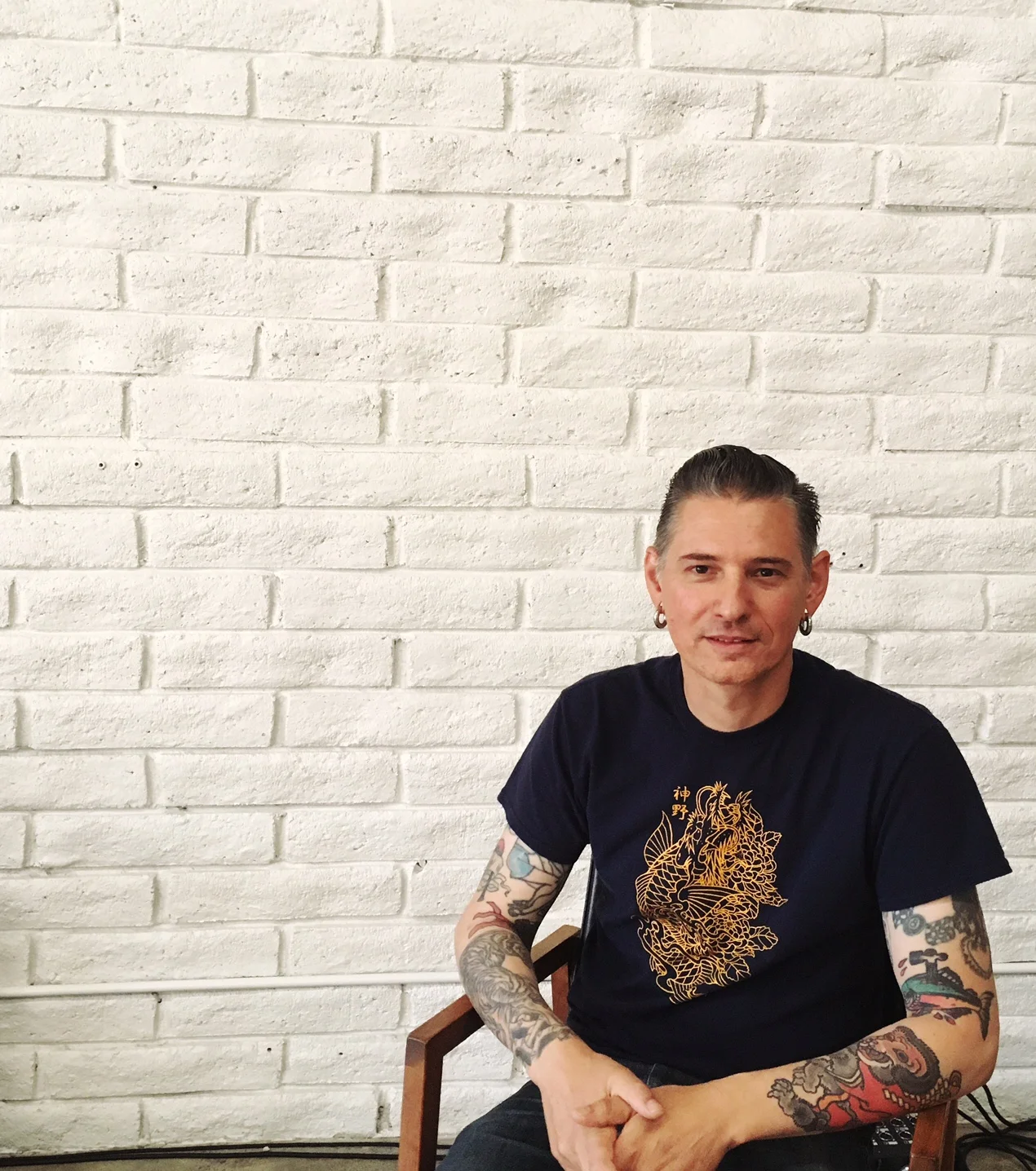Artist Highlight: Martin D.C.
Martin is from Argentina, he has lived in Los Angeles, Kansas, and now Castro Valley. Martin is a tattoo artist and painter. Martin started tattooing in 1991. During that time he was also studying graphic design and working in the bicycle industry. He became more immersed in tattooing when he lived in Los Angeles, during that time he tattooed in the Americana style of nautical tattoos, eagles, and pin-up girls and so on. Eventually, he found the Japanese style of tattooing, “I discovered it by accident I had a friend asking me to fix a Japanese piece he had and it was really old and the artist wasn’t around anymore.” Martin told his friend he was not familiar with the style, but this opportunity motivated him to study Japanese culture, art history, and the language to learn as much as he could about the Japanese style. Martin likes that in the Japanese style of tattooing the entire body is seen as one piece, he finds the freedom to create large pieces fascinating. Martin enjoys Japanese tattoos because, “they stand the test of time.” Martin moved to Castro Valley a year ago come September. He describes tattooing as, “a learning journey . . . you’re always evolving,” he enjoys being in such close proximity to artists in San Francisco. Many artists are accessible and willing to network in the Bay Area, “if you’re a professional you learn from a simple conversation . . . I say the whole Bay Area has a tradition of tattooing.” Martin’s art has been influenced by place, in Los Angeles he was inundated with requests for portraits, praying hands, and Jesus Christ tattoos. With numerous requests for script writing in LA, Martin learned as much as he could from the Latino tattoo artists, some as young as fourteen years old. Martin has noticed the diversity of people who love the Japanese style, he commented, “You can see people from Silicon Valley who go back and forth to Japan because of their jobs and you can see them with suit and tie and you don’t know the guy have whole body style of Japanese tattoo or Americana.” Martin is excited that the acceptance of tattoos has allowed his clients to feel more comfortable with using more of their bodies as a canvas and allowing a liberal use of colors.
Artist Highlight: Eric Stevens
Eric, grew up in Alabama, lived in Chicago a bit, and found his way out to the Bay Area in 2004, through, “a series of experiments for the most part.” He attended Auburn College and studied industrial design which would later inspire him to pursue furniture work. Eventually, Eric worked for a furniture design firm but “got a little bit burned out.” He left the firm and decided to open his own shop so he could better understand what it meant to design things for other people. Eric found his design style through what was lacking when he looked at carpentry and wood working magazines. He felt inspired after reading about an artist who used mechanisms to carve wood. Although he didn’t implement the techniques immediately, it laid the foundation for experimentation with his creative medium 5 years later. He credits creative experimentation as the catalyst for making a return to furniture and create a cohesive body of work again. Eric reflected on making 100 pieces in 100 days, “So each piece was made in basically a day sometimes it would lapse over to finishing but my goal was to photograph each piece and publish it.” He commented that the biggest hurdle in accomplishing his goal was persistence and it took constantly “showing up,” for his art amidst all the things happening in life to pull him away from his art. He found immense focus through the experimental 100 pieces and worked with intention to, “try to do a better job each time.” He trashed approximately 40 of the pieces. He said there are times when he wants to trash everything he makes and commented that his work is subjective in the eyes of other people. He accepts that people either like or dislike his work while acknowledging that he has not pushed himself to sell his pieces. Since he has not moved many pieces, Eric is often surrounded by his art, which he compares to, “staring at yourself in the mirror.” Each piece Eric makes takes time. The cost of metal plates and studio space and the lumber all adds up and is factored into how he feels about his work. Eric’s shift from Oakland to the Eden area has been gradual; he has been in the area for a year and a half and is slowly meeting new people. The Oakland area is full or artists flowing from San Francisco, he commented on the way artists and creativity in Oakland feeds off of one another. Eric is slowly immersing himself in the community and making connections, most recently at the Castro Valley lumber yard, “this gem in the middle of nowhere, kind of hidden and that was fantastic, they have wood that’s been drying in the air for about 40 years and just giant pieces of redwood.” Eric identified that space is a commodity in the area and is much needed in order to get artists creating and gathering in a community setting.


